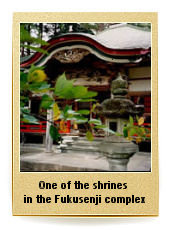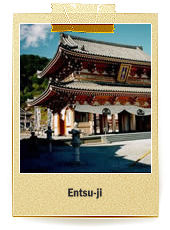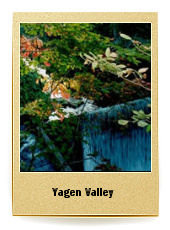More to the North
We found ourselves in the mountains again. From a post office in Tono we sent a parcel to Poland. It cost us no less than JPY 7500! Still, we had no other choice, as the numerous souvenirs that we carried were getting heavier and heavier. Back in Poland, I was dreadfully disappointed to find out that a half of the parcel contents had got broken. If I had predicted this, I would have gladly carry that extra 2 kg of luggage. In Tono we saw some interesting things, such as the Gohyaku Rakan valley with 500 statues of Buddha, carved in rock and covered with moss. In the nearby Fukusenji temple complex we saw a charming garden with numerous pagodas and shrines. One of them housed a 17-metre statue of Kannon Buddha. With few tourists around, the conditions for contemplation were perfect, which gave the place even more charm.
 Heading north, we got caught in the rain on a mountain pass. While cycling downhill, we were soaked to the skin, so we took a turn towards the first roadside farm we saw. With nobody in sight, we took shelter in a barn. As soon as we changed our clothes, we bumped into the owner, who invited us into his house so that we could get warm and dry our clothes. The farmer was a simple man and talking to him was not easy. Some Japanese sentences I had learned in advance came in handy, for example "Watashiwa Poorando kara kanko de kimashita", - which meant: "We are tourists from Poland".
Heading north, we got caught in the rain on a mountain pass. While cycling downhill, we were soaked to the skin, so we took a turn towards the first roadside farm we saw. With nobody in sight, we took shelter in a barn. As soon as we changed our clothes, we bumped into the owner, who invited us into his house so that we could get warm and dry our clothes. The farmer was a simple man and talking to him was not easy. Some Japanese sentences I had learned in advance came in handy, for example "Watashiwa Poorando kara kanko de kimashita", - which meant: "We are tourists from Poland".
Next day we reached the Ryusendo cave. Judging by the admission fee – JPY 800 – the place seemed worth seeing. However, I was a bit disappointed. I can only mention that the site features several deep underground lakes. The deepest one (138 m) also prides itself on the world's best water transparency, reaching 41.5 m. From the mountain region we cycled back to the Pacific shore, and headed to the north of Honshu. On the Shimokita Peninsula, we spent one night just a few kilometres away from a nuclear power station. - what a chilling experience. Afterwards we went to the Osorezan volcano region, with the Entsu-ji temple "crouching" on the lake at the foot of the volcano.
 There was a distinct smell of hydrogen sulphide everywhere. Close to the temple we saw interesting rock formations, serving as evidence of continuing volcanic activity. Stinking smoke still billowed out of some rock heaps – lunar landscape indeed. Rhododendrons – with their eye-catching red leaves – were the only plants capable of surviving in such conditions. At that time some minor festival took place in Entsu-ji. A few fortune tellers tried to predict our future, falling into a trance when passing on messages from spirits.
There was a distinct smell of hydrogen sulphide everywhere. Close to the temple we saw interesting rock formations, serving as evidence of continuing volcanic activity. Stinking smoke still billowed out of some rock heaps – lunar landscape indeed. Rhododendrons – with their eye-catching red leaves – were the only plants capable of surviving in such conditions. At that time some minor festival took place in Entsu-ji. A few fortune tellers tried to predict our future, falling into a trance when passing on messages from spirits.
 Early next morning we visited the picturesque Yagen Valley, and later reached the port of Oma, from where we were supposed to take a ferry to Hokkaido. Much to our surprise, all information was provided in Japanese only, and no ticket clerks could speak foreign languages. But what are hands for! Besides, we knew some basic vocabulary (e.g. jitensha – bicycle) and a few Japanese sentences. After an hour and a half cruise we set our feet in Hakodate – one of the major ports of Hokkaido, Japan's northernmost island (aside from the Kuril Islands over which there still is a dispute with Russia).
Early next morning we visited the picturesque Yagen Valley, and later reached the port of Oma, from where we were supposed to take a ferry to Hokkaido. Much to our surprise, all information was provided in Japanese only, and no ticket clerks could speak foreign languages. But what are hands for! Besides, we knew some basic vocabulary (e.g. jitensha – bicycle) and a few Japanese sentences. After an hour and a half cruise we set our feet in Hakodate – one of the major ports of Hokkaido, Japan's northernmost island (aside from the Kuril Islands over which there still is a dispute with Russia).
 Heading north, we got caught in the rain on a mountain pass. While cycling downhill, we were soaked to the skin, so we took a turn towards the first roadside farm we saw. With nobody in sight, we took shelter in a barn. As soon as we changed our clothes, we bumped into the owner, who invited us into his house so that we could get warm and dry our clothes. The farmer was a simple man and talking to him was not easy. Some Japanese sentences I had learned in advance came in handy, for example "Watashiwa Poorando kara kanko de kimashita", - which meant: "We are tourists from Poland".
Heading north, we got caught in the rain on a mountain pass. While cycling downhill, we were soaked to the skin, so we took a turn towards the first roadside farm we saw. With nobody in sight, we took shelter in a barn. As soon as we changed our clothes, we bumped into the owner, who invited us into his house so that we could get warm and dry our clothes. The farmer was a simple man and talking to him was not easy. Some Japanese sentences I had learned in advance came in handy, for example "Watashiwa Poorando kara kanko de kimashita", - which meant: "We are tourists from Poland".
Next day we reached the Ryusendo cave. Judging by the admission fee – JPY 800 – the place seemed worth seeing. However, I was a bit disappointed. I can only mention that the site features several deep underground lakes. The deepest one (138 m) also prides itself on the world's best water transparency, reaching 41.5 m. From the mountain region we cycled back to the Pacific shore, and headed to the north of Honshu. On the Shimokita Peninsula, we spent one night just a few kilometres away from a nuclear power station. - what a chilling experience. Afterwards we went to the Osorezan volcano region, with the Entsu-ji temple "crouching" on the lake at the foot of the volcano.
 There was a distinct smell of hydrogen sulphide everywhere. Close to the temple we saw interesting rock formations, serving as evidence of continuing volcanic activity. Stinking smoke still billowed out of some rock heaps – lunar landscape indeed. Rhododendrons – with their eye-catching red leaves – were the only plants capable of surviving in such conditions. At that time some minor festival took place in Entsu-ji. A few fortune tellers tried to predict our future, falling into a trance when passing on messages from spirits.
There was a distinct smell of hydrogen sulphide everywhere. Close to the temple we saw interesting rock formations, serving as evidence of continuing volcanic activity. Stinking smoke still billowed out of some rock heaps – lunar landscape indeed. Rhododendrons – with their eye-catching red leaves – were the only plants capable of surviving in such conditions. At that time some minor festival took place in Entsu-ji. A few fortune tellers tried to predict our future, falling into a trance when passing on messages from spirits.
 Early next morning we visited the picturesque Yagen Valley, and later reached the port of Oma, from where we were supposed to take a ferry to Hokkaido. Much to our surprise, all information was provided in Japanese only, and no ticket clerks could speak foreign languages. But what are hands for! Besides, we knew some basic vocabulary (e.g. jitensha – bicycle) and a few Japanese sentences. After an hour and a half cruise we set our feet in Hakodate – one of the major ports of Hokkaido, Japan's northernmost island (aside from the Kuril Islands over which there still is a dispute with Russia).
Early next morning we visited the picturesque Yagen Valley, and later reached the port of Oma, from where we were supposed to take a ferry to Hokkaido. Much to our surprise, all information was provided in Japanese only, and no ticket clerks could speak foreign languages. But what are hands for! Besides, we knew some basic vocabulary (e.g. jitensha – bicycle) and a few Japanese sentences. After an hour and a half cruise we set our feet in Hakodate – one of the major ports of Hokkaido, Japan's northernmost island (aside from the Kuril Islands over which there still is a dispute with Russia).



